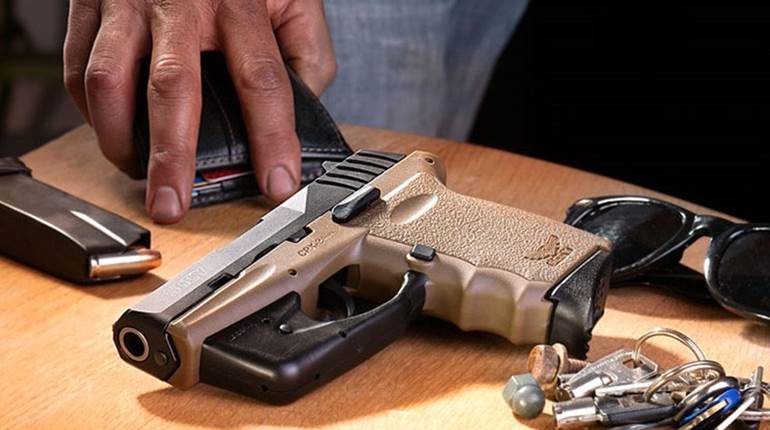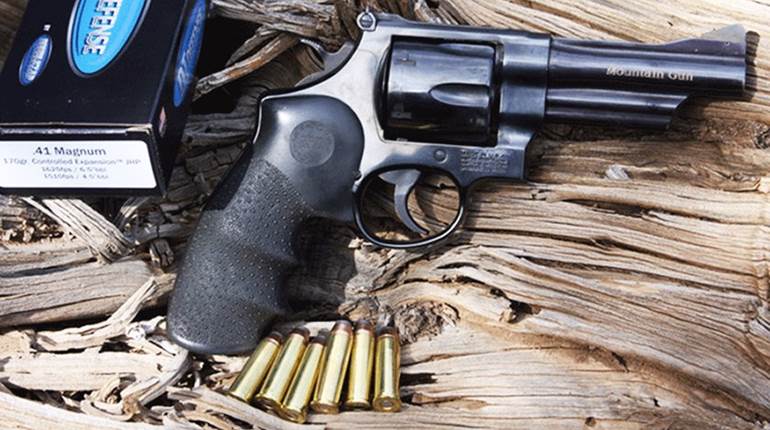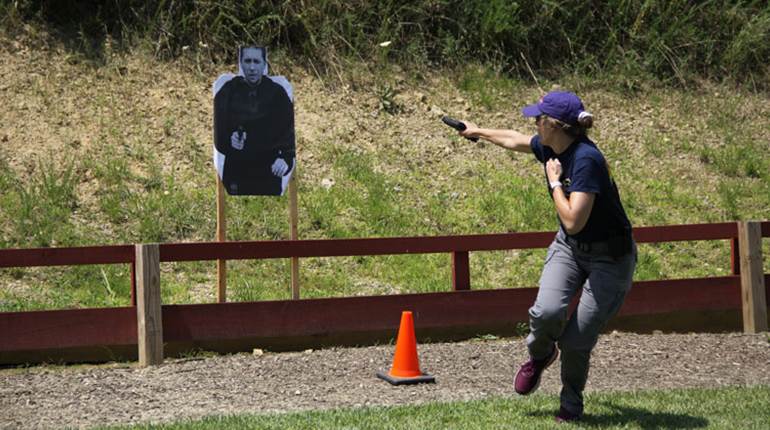
In the early 1920s, times were tough for Spanish gunmakers. World War I had been over for a number of years, and the market was awash with surplus arms sold for less than the cost of new production. Also, beginning in 1920, the federal police force, or Guardia Civil, had to approve all pistol sales, except single-shot .22s. It was only natural for Spanish firms to look abroad, but it was difficult to compete against such established giants as Colt and Smith & Wesson in the United States. Opportunity came in Asia, a part of the world with a growing demand where trademarks were not as deeply entrenched.
Despite China’s great size, plentiful resources and burgeoning population, the Ch’ing dynasty had never seen fit to establish a modern, centralized military. China was defeated by Japan in 1895, and faced with huge reparations and loss of face, China’s intellectuals clamored for revolution. In 1911, the Ch’ing Dynasty was replaced by a Republican government presided over by Yuan Shih-k’ai, a former general whose personal ambitions invariably superseded those of the state. To ensure his position, he eliminated all serious competition. Following Yuan’s unexpected death in 1916, China found itself leaderless and with a corrupt government. As many potential successors struggled for individual power, China plunged into an era of turmoil punctuated by a relentless series of military conflicts.
The “warlord period,” from 1916 to 1928, was a dark age for modern China, characterized by military instability, greed and social disruption. Resolute in their desire for absolute control, numerous warlords fielded huge armies to battle for regional dominance and personal gain. By any measure, their troop strengths were extraordinary—and everyone needed arms.
As China’s isolationist policy had left its arms industry in technological backwater, virtually all the guns and munitions had to be imported. Cash was not an issue—in some cases the warlords allotted up to 90 percent of their tax revenue on arms—and there was no standardization. New or used, it didn’t matter. The most important issue was to get arms and ammunition to their troops as quickly as possible.
But there were a few obstacles. To limit the warlords’ access to materiel and presumably to promote peace, Britain, France, Russia, Spain and the United States signed the May 5, 1919, Arms Embargo Agreement to “restrain their subjects and citizens from exporting to or importing into China, arms and munitions of war and materiel destined exclusively for their manufacture.” Curiously, handguns—considered a secondary arm of minimal importance—were exempt from the agreement. Not surprisingly, in spite of the public posturing, the Arms Embargo was widely ignored. The reason was economic. The warlords were desperate for guns, and everyone else wanted the warlords’ money. If one country refused to negotiate there were always others. In the end, practicality superseded politics as arms were ultimately shipped from virtually every country that had signed or expressed support for the embargo.
At first, the Spanish makers competed voraciously against each other, supplying small-caliber blowback pistols, largely 7.65 mm “Eibar-type” guns as had been used by the French in World War I. Mauser Werke of Germany found itself in a very different position. In 1896, the firm developed its C96, or “broomhandle,” that could be used as a traditional pistol, stored in the shoulder stock or—when attached to its stock—function as a short-barreled carbine. The cartridge was potent and the guns highly reliable. Any and all versions could be legally sold to the Chinese. Although Mauser’s production was then curtailed by the Treaty of Versailles, there was such an incentive to sell guns that all sorts of loopholes were explored with unbridled enthusiasm. The Chinese were particularly delighted with the C96 and purchased the design with wild abandon. According to author Thomas B. Nelson, more than 300,000 were eventually exported from Germany, either directly or via Japanese traders. For a few years, Mauser couldn’t make the guns fast enough.
That success did not go unnoticed. The first Spanish firm to take up the competitive reins was Beístegui Hermanos, a factory in Eibar. Although the peculiarities of Spanish patent law would have allowed Beístegui to have made an exact copy of the C96, the firm chose to make an externally similar pistol with different mechanics for more expedient production. In some cases, the changes were real improvements. While the C96 had an integral barrel and barrel-extension, Beístegui assembled the unit with separate pieces—a process that required less setup time and allowed the barrel to be replaced as an individual component. Making the bolt with a cylindrical shaft rather than a squared shaft allowed further economy. As Mauser held the upper hand, the Beístegui pistol had to be equally reliable but significantly cheaper.
Beístegui had its first C96-type pistol, designated the Model H, in production by 1926. To more closely emulate the C96’s looks, the firm milled similar panels onto each side of the frame and fitted the gun with a small ring hammer and a Bolo grip. Curiously, though the “Royal” trade name was already recognized in Asia, the markings on the first Model Hs were largely limited to the serial number and Eibar test proofs. By 1927, the Model H had evolved to its most common configuration in which the rear frame panels were eliminated and wherein the grip was enlarged to more closely mimic the standard C96. By that time, Beístegui had also changed to marking most of its guns “‘Royal’ Patent No. 105614,” a reference to the locking block patent.
Meanwhile, in Guernica Astra-Unceta y Cía decided to enter the fray. Export Director Ernesto Borchers went on a several-month trip to Asia. After visiting with a number of Japanese traders and mainland distributors, Borchers wrote back, “There are sought fabulous quantities of 7.63 mm pistols and, according to the indications, Echeverría (Star–another firm in Eibar) must be doing good business. We could do more, since we know the clientele better.” In another letter he mentioned, “Some clients are interested in Astra, but most want to buy ‘Royal,’ and there is no one who can cure them of this mania.” He returned from the voyage with a contract for 72,000 pistols in calibers 7.63 mm Mauser and 7.65 mm through a three-year period.
By December 1927, Astra had completed the first of its M900-series pistols. Like the Model H, the M900 was externally similar to the C96, with a small ring hammer and Bolo grip, but with distinctive mechanical differences. Unquestionably, its hallmark feature was the removable sideplate. Pushing out a single pin allowed the sideplate to slide off the frame, exposing the lockwork and dazzling the first-time observer with its jeweled inner surfaces. Other important changes from the Mauser included the use of a pinned locking block, a screwed-in barrel and a separate barrel return spring.
As the Model H and M900 were designed using the standard C96 as a benchmark, it should not be surprising that the three guns shared a number of features. Initially, they were all semi-automatic with a fixed 10-shot magazine that was loaded with a stripper clip. They also had a tangent rear sight graduated to 1,000 meters and came with a separable shoulder stock that was matched to the pistol. But over time, as in any competitive market, changes ensued.
In late 1927, Beístegui introduced a selective-fire version of the Model H. An advertisement from the period called the implementation a “sensational invention,” in which the pistol with shoulder stock combination was billed as “the most handy, cheapest and completely reliable machine gun.” Of course, practicality was an issue. With a cyclic rate of 900 rounds per minute (r.p.m.), it took less than a second to empty. But that didn’t really matter to the warlords who found the prospect of “wild shooting” irresistible. Rather than train recruits to lightly tap the trigger, they advised them to rotate their guns 90 degrees before commencing fire. Under those conditions, the uncontrolled recoil would spray the bullets in an arc parallel to the ground. The warlords were ecstatic, and Beístegui’s sales boomed. Not to be left behind, Astra developed its Model 901 in 1928. Though it would have been more user-friendly to mount the selector switch on the left side of the frame, this area was already occupied by the sideplate. Rather than undertake a major redesign, Astra mounted the selector switch on the right side, a precedent that continued throughout its series of pistols.
The next step was to increase the pistol’s ammunition capacity, and Beístegui and Astra introduced a 20-shot pistol. Unlike Mauser, whose 20-shot frame was made from a single forging, Beístegui and Astra dovetailed a 10-shot extension onto a standard frame. At the same time, in keeping with the maxim “bigger is better,” the barrel length was increased from 140 mm (5.5 inches) to 180 mm (6.2 inches). A period advertisement suggested that Beístegui may have been the first to offer the 20-shot option, introduced for the Model H and then continued for the MM31, but Astra soon followed, naming its 20-shot pistol the M902. To accommodate these huge pistols, the shoulder stock needed significant modification. The neck was lengthened and a channel was routed into the body for the magazine extension, which was protected by a rotatable leather boot. Beístegui and Astra must have agreed on this approach, for their stocks differed in only the smallest details.
Many of these changes took place in 1928, one of the biggest years for Spanish arms exports. According to Astra’s records, virtually all the guns from this period were earmarked for China. At first, most were transported by Japanese traders. In 1929, to engage the Chinese more directly, Astra founded the “Astra-China Company, Ltd.” in Shanghai. A few years later, underscoring the importance of this market, Astra marked the sideplate of a number of its M900s with Chinese characters that translated to “Made in Spain.”
By late 1929 Beístegui must have felt its market share eroding, for the firm abandoned the Model H in favor of the MM31 (Modelo Militar 1931), which more closely approximated the C96. The new gun was customarily fitted with a selector switch, but looked like a Mauser and was marked in the same areas as a Mauser. It even disassembled like a Mauser. If imitation is the most sincere form of flattery, Mauser should have been very proud—but nothing could have been further from the truth. Mauser was furious, printing cautionary warnings in its advertisement for customers to “avoid spurious copies.” To no real surprise, the warnings were ignored. After all, the warlords didn’t care who made the guns and few, if any, of their troops could read.
From 1929 to early 1931, the Spanish gunmakers led an idyllic existence. Life in the northern Basque Provinces was relatively peaceful, and business abroad was terrific. By early 1932, the two firms transitioned to making detachable-magazine pistols, largely prompted by Mauser’s introduction of its now-famous M712 Schnellfeuerpistole. Recognizing the importance of riding Mauser’s coattails, Beístegui designed its pistol, later known as the fourth variation MM31, to use an interchangeable magazine. Astra’s counterpart became the M903. Regardless of manufacturer, most magazines were 10- or 20-shot.
Through circumstances beyond the Spaniards’ control, relatively few of these pistols made it into China. By the time they were introduced, warlord militarism had been largely eradicated by Chiang Kai-Shek’s Nationalists. What was left of the arms market collapsed in 1932, after Japan attacked mainland China. Clearly, the Spanish manufacturers had to find a new opportunity. The early to mid-1930s were difficult for the Spanish arms manufacturers, as political turmoil resulted in more stringent regulation, occasional seizures and forced closings. Not only was China’s door closed but a number of Latin American countries had also enacted more restrictive legislation. Customers dried up and profit margins plunged.
To remain viable, many arms manufacturers gave up making guns, preferring to diversify into less controversial territory. A glimmer of hope emerged in late 1933, when the Guardia Civil announced a new pistol trial for its Guardia de Asalto, or “Assault Guards.” The gun needed to be chambered for the regulation 9 mm Largo (Bergmann) but have a reduced cyclic rate for better accuracy and lower ammunition consumption. Beístegui and Astra jumped at the opportunity. After all, winning the trial would be accompanied by considerable prestige and provide a better foothold upon which to compete with Star-Bonifacio Echeverría, still the main handgun supplier to the Guardia Civil. More importantly, it would provide an immediate source of well-needed cash.
For the next few months, Beístegui, Astra and Star worked furiously, each taking a different approach to meet the Guardia’s needs. Beístegui eventually submitted its MM34, an MM31-type pistol with a pneumatic retarder mounted on the frame’s backstrap under the grips. On the frame’s left, just above the grip, was a three-position lever that could be adjusted for the desired cadence that varied from 2-3 to 9-10 shots per second. Many of the early guns had a finned barrel whose first impression recalled that of the Thompson submachine gun.
In the meantime, Astra and Star developed mechanical retarders. The Astra entry, named the Modelo F, was similar to the M903 but with a “mecanismo moderador” under the grip. In this case, the retarder was a weighted flywheel that was connected to the hammer by two pawls and their linkages. As the hammer fell, its movement was transferred to the flywheel, rotating it in one direction, then the other, essentially braking the first part of the hammer fall. The net result slowed the cyclic rate from 900 to 350 r.p.m. Star made a Model M marked “Modelo Militar” with a spring-tensioned retarder mounted under the right grip panel. Whether the Star was formally tested remains unknown.
The Guardia chose the Modelo F and gave Astra an order for 1,000 pistols. That decision was the death knell for Beístegui’s broomhandles. Washing its hands of firearms, Beístegui sold off most of its remaining inventory, mothballed the partially assembled guns and spare parts, and returned with renewed vigor to its bicycle production.
In July 1936, shortly after the onset of the Spanish Civil War, Republican forces commandeered many of the arms plants, including those of Beístegui and Astra. From that point forth, all production was determined by government decree. Beístegui was to assemble whatever pistols it could from parts on-hand for immediate issue. The urgency was such that many of the guns, mostly fourth variation MM31s, were assembled without proofs or other customary markings. Astra’s production was subject to the same authority. Between July 1936 and April 1937, the Euskadian Government, then allied with the Republicans, impounded more than 2,000 M900 series pistols in inventory while forcing Astra to make M300s and M400 (1921)s.
By early 1937, Francisco Franco’s Nationalists were gaining ground. Not surprisingly, one of their objectives was to control the Basque Provinces, for therein lay most of Spain’s small arms manufacturers. On April 26, 1937, the Nationalists shelled the town of Eibar, destroying the Beístegui factory and all of its records. At the same time, Guernica was bombed by the German Condor Legion. Remarkably, the Astra factory escaped unscathed. Just a few days later, after most of the turmoil had subsided, Astra was back to full production but now under Nationalist authority.
After the Civil War ended in 1939, Franco maintained a close watch over the handgun industry. Between 1939 and 1941, he issued a number of decrees that pared down the number of private-sector manufacturers to just four firms: Astra, Echasa, Llama and Star. For the most part, Astra was pleased—fewer competitors meant more business. Even better, there was plenty of work. The world was now in the midst of World War II, and Astra was a key supplier.
Despite Spain’s “neutrality,” Franco was well-known for having a blind eye when it came to supplying the Nazis with small arms. Between 1941 and 1944, Astra made and exported thousands of M200, M300, M400 (1921), M600 and M900 series pistols to the German forces in southern France. Concerning the M900 series, two shipments were authorized. The first, sent in November 1940, consisted of 1,002 M903s; the second left the factory in March 1943 and consisted of 1,052 M900s, 13 M902s and 987 M903s.
In 1944, Franco issued a regulation prohibiting manufacture of military arms except in government arsenals. As had been true years earlier, military arms were defined to include pistols with selective-fire devices or capable of being fitted to a shoulder stock. Under the new law, Astra could complete and export the pistols that were finished, or partially finished, but was prohibited from manufacturing new guns. The last guns were Model Es, a hybrid of the Modelo F top and M903 frame, exported primarily to Third World countries between 1949-1951, with the last guns leaving Astra in 1960.
In retrospect, the Spanish firms accounted for only a small number of C96-type guns. Beístegui’s production of Model Hs, MM31s and MM34s approached 33,000, while Astra completed 34,336 Model 900 series pistols. In contrast, Mauser’s C96 production exceeded 1 million guns. Nevertheless, the Spanish makers were responsible for an extraordinary level of ingenuity, particularly their cyclic-rate-retarded versions, and implemented a number of advances that even Mauser must have admired. Had it not been for market forces beyond their control, the broomhandles of Beístegui and Astra may well have overshadowed those of Mauser, bringing an entirely new association to the phrase “Made in Spain.”






































